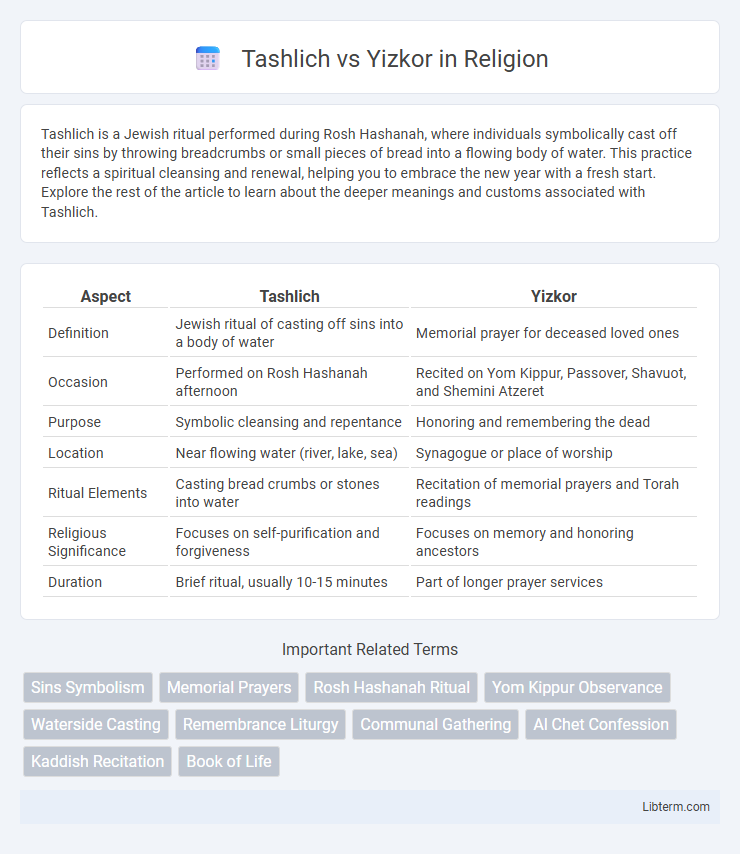Tashlich is a Jewish ritual performed during Rosh Hashanah, where individuals symbolically cast off their sins by throwing breadcrumbs or small pieces of bread into a flowing body of water. This practice reflects a spiritual cleansing and renewal, helping you to embrace the new year with a fresh start. Explore the rest of the article to learn about the deeper meanings and customs associated with Tashlich.
Table of Comparison
| Aspect | Tashlich | Yizkor |
|---|---|---|
| Definition | Jewish ritual of casting off sins into a body of water | Memorial prayer for deceased loved ones |
| Occasion | Performed on Rosh Hashanah afternoon | Recited on Yom Kippur, Passover, Shavuot, and Shemini Atzeret |
| Purpose | Symbolic cleansing and repentance | Honoring and remembering the dead |
| Location | Near flowing water (river, lake, sea) | Synagogue or place of worship |
| Ritual Elements | Casting bread crumbs or stones into water | Recitation of memorial prayers and Torah readings |
| Religious Significance | Focuses on self-purification and forgiveness | Focuses on memory and honoring ancestors |
| Duration | Brief ritual, usually 10-15 minutes | Part of longer prayer services |
Understanding Tashlich: Origins and Meaning
Tashlich is a Jewish ritual performed on Rosh Hashanah involving the symbolic casting away of sins by throwing breadcrumbs into a flowing body of water, reflecting humility and spiritual cleansing. Originating from biblical verses such as Micah 7:19, which speaks of God casting sins into the depths of the sea, Tashlich represents a physical manifestation of repentance and renewal. Unlike Yizkor, a memorial prayer for deceased loved ones recited on specific holidays, Tashlich emphasizes personal atonement and forgiveness at the start of the Jewish new year.
Yizkor: Significance and Historical Background
Yizkor is a deeply significant Jewish memorial prayer recited to honor deceased loved ones, traditionally observed during major holidays such as Yom Kippur, Passover, and Shavuot. Its historical origins date back to medieval Europe, where communal remembrance was crucial for preserving collective memory and spiritual connection. Unlike Tashlich, which involves casting sins into water during Rosh Hashanah, Yizkor centers on prayer, reflection, and the affirmation of life through memory.
When Are Tashlich and Yizkor Observed?
Tashlich is observed on the afternoon of Rosh Hashanah, typically on the first day, but if it falls on Shabbat, it is postponed to the second day or another suitable day during the Ten Days of Repentance. Yizkor is recited four times a year during major Jewish festivals: Yom Kippur, Passover, Shavuot, and Sukkot, serving as memorial prayers for departed loved ones. Both rituals provide spiritual opportunities for reflection and remembrance within the Hebrew calendar's significant observances.
Ritual Practices: How Tashlich Is Performed
Tashlich is performed by symbolically casting breadcrumbs or small stones into a flowing body of water, such as a river or stream, to represent the casting away of sins during the High Holy Days. This ritual usually takes place on Rosh Hashanah afternoon, often near a natural source of water, and involves reciting specific prayers and psalms to invoke divine forgiveness. In contrast, Yizkor is a memorial prayer recited in the synagogue on Yom Kippur, Shemini Atzeret, Passover, and Shavuot, focusing on remembering deceased loved ones rather than symbolic acts of repentance.
Yizkor Service: Customs and Prayers
Yizkor service is a central Jewish memorial ritual recited four times annually to honor deceased loved ones, featuring specific prayers such as El Maleh Rachamim and the Yizkor prayer itself. Customs include communal synagogue gatherings where individuals recite Yizkor to invoke divine remembrance and ask for the soul's elevation. The service emphasizes collective mourning and personal reflection, contrasting with Tashlich's symbolic casting away of sins into water during Rosh Hashanah.
Symbolic Differences Between Tashlich and Yizkor
Tashlich symbolizes the casting away of sins by throwing bread crumbs into a body of water, representing purification and spiritual renewal during Rosh Hashanah. Yizkor, recited on Yom Kippur and other Jewish holidays, serves as a memorial prayer for deceased loved ones, highlighting remembrance and honoring their souls. The key symbolic difference is Tashlich's focus on forgiveness and cleansing, whereas Yizkor centers on memory and commemoration.
Community Participation in Tashlich vs Yizkor
Tashlich involves active community participation as congregants gather by natural bodies of water to symbolically cast away sins, fostering a collective spiritual renewal. In contrast, Yizkor is typically observed within synagogue services, where communal remembrance emphasizes solemn reflection and honoring deceased loved ones. The physical gathering of Tashlich encourages communal interaction and shared rituals, while Yizkor's participation centers on unified prayer and communal memory.
Emotional Impact: Repentance vs Remembrance
Tashlich evokes deep emotional impact through physical acts of repentance by casting sins into flowing water, symbolizing cleansing and renewal during the High Holy Days. Yizkor creates a solemn atmosphere of remembrance, stirring heartfelt memories and honoring deceased loved ones within synagogue services on Yom Kippur, Passover, Shavuot, and Sukkot. Together, these rituals provide distinct emotional experiences: Tashlich focuses on personal spiritual purification while Yizkor emphasizes communal mourning and memorialization.
Tashlich and Yizkor in Contemporary Jewish Life
Tashlich, a ritual performed during Rosh Hashanah, involves casting breadcrumbs into a flowing body of water to symbolically cast away sins, reflecting themes of repentance and renewal in contemporary Jewish practice. Yizkor, a memorial prayer recited on Yom Kippur, Shemini Atzeret, Passover, and Shavuot, serves as a communal remembrance for deceased loved ones, reinforcing collective memory and spiritual connection. Both rituals remain integral in modern Jewish life, balancing personal introspection with communal solidarity through distinct yet complementary acts of reflection.
Key Takeaways: Choosing Reflection and Memory
Tashlich involves symbolically casting away sins into flowing water during Rosh Hashanah, emphasizing personal reflection and spiritual renewal. Yizkor is a memorial prayer recited on Yom Kippur and other holidays, focusing on honoring deceased loved ones and collective memory. Choosing between Tashlich and Yizkor depends on whether one seeks self-reflection and forgiveness or remembrance and tribute to departed family members.
Tashlich Infographic

 libterm.com
libterm.com